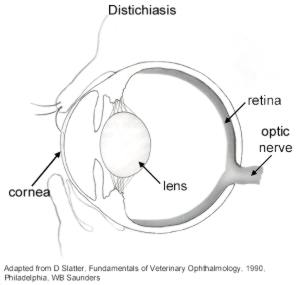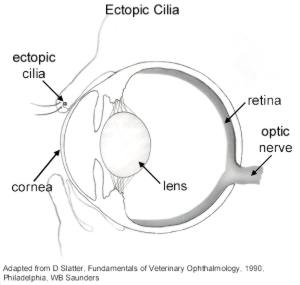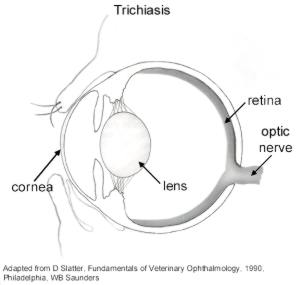related terms: distichiasis, trichiasis, ectopic cilia What are eyelash abnormalities? Normally the eyelashes (or cilia) grow from follicles in the eyelid. Abnormalities of the eyelash are a common hereditary problem in dogs. The three types are: distichiasis, in which extra eyelashes grow from abnormal follicles located on the inside edge of the eyelid. They may be singular or multiple. ectopic cilia, in which the extra eyelash grows through the eyelid to the inside.One or more ectopic cilia may be present. trichiasis, in which eyelashes growing from normal sites turn inward. The eyelashes are often abnormally long. With any of these disorders, the clinical signs relate to irritation of the cornea (the surface of the eye). The degree of discomfort varies greatly, depending on the number of abnormal cilia, and whether they are very fine, or more coarse. How are eyelash abnormalities inherited? The mode of inheritance has not been established. It is most common in the breeds listed below, but can be seen in any breed. What breeds are affected by eyelash abnormalities? distichiasis: common in the American and English cocker spaniel, Shih tzu, toy and miniature poodle, golden retriever, Pekingese, Shetland sheepdog; also seen in Australian shepherd, Bedlington terrier, Boston terrier, English bulldog, boxer, Cardigan Welsh corgi, Cavalier King Charles spaniel, Chesapeake Bay retriever, Clumber spaniel, collie (rough and smooth), curly-coated retriever, dachsund (all varieties), Doberman pinscher, field spaniel, flat-coated retriever, German shepherd, German short-haired pointer, Great Dane, Irish setter, Labrador retriever, Lhasa apso, Lowchen, Norwegian elkhound, Nova Scotia duck tolling retriever, Pembroke Welsh corgi, pomeranian, Portuguese water dog, pug, samoyed, Saint Bernard, Sussex spaniel, Tibetan spaniel, Weimaraner, Welsh springer spaniel, Yorkshire terrier ectopic cilia: bulldog, Lhasa apso, Pekingese, Shih tzu trichiasis: American cocker spaniel, Pekingese. In brachycephalic breeds, trichiasis is common because of an excessive nasal skin fold that places cilia close to the cornea.` For many breeds and many disorders, the studies to determine the mode of inheritance or the frequency in the breed have not been carried out, or are inconclusive. We have listed breeds for which there is a consensus among those investigating in this field and among veterinary practitioners, that the condition is significant in this breed. What do eyelash abnormalities mean to your dog & you? Often the extra eyelashes are very soft and fine, and cause no problems. However if there is reduced tear production or if the hairs are coarse and stiff, you will likely see signs of irritation such as reddening of the conjunctiva (the inside of the lid), excessive tearing, and squinting. Your dog may paw or rub the eyes. Corneal ulceration may occur, and this will increase your dog's discomfort. Ectopic cilia are particularly irritating and likely to cause corneal ulcers. How are eyelash abnormalities diagnosed? Very bright light and magnification are required to see the extra eyelashes. Your veterinarian will also do a fluoroscein dye test if there is a possibility of corneal ulceration. Sometimes the extra eyelashes can be very difficult to see, and may only be found when your veterinarian is trying to determine the cause of recurring corneal ulcers in your dog. How are eyelash abnormalities treated? No treatment is required for extra eyelashes that are fine and causing no irritation. If corneal ulceration is present, it is treated with antibiotic medication. If abnormal eyelashes are the cause, they must be treated as well or the ulcers will recur. Where there is chronic irritation with or without ulceration, there are several procedures that can be done, depending on the number and location of the abnormal lashes. These range from electroepilation (effective if there are only a few abnormal lashes), to removal of the aberrant follicle for an ectopic cilium, to cryosurgery to destroy the abnormal hair follicles. Cryosurgery is the most effective treatment for distichiasis, and is less commonly associated with recurrence than electrolysis. FOR MORE INFORMATION ABOUT THIS DISORDER, PLEASE SEE YOUR VETERINARIAN. Copyright © 1998 Canine Inherited Disorders Database. All rights reserved. Revised: September 20, 2004. |


